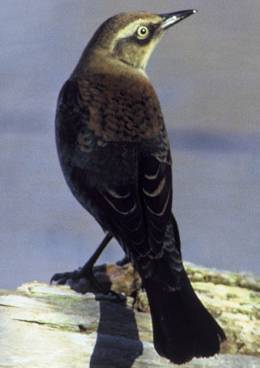Who knew they were disappearing? And, in reality, who knew there was such a thing as a rusty blackbird (Euphagus carolinus). “I think of lot of birders do enjoy rusty blackbirds,” said Nick Sly, a graduate student in the Department of Animal Biology at the University of Illinois. “They aren’t a species that aren’t generally known to the broader public.”Sly is a volunteer coordinator for this year’s Rusty Blackbird Spring Migration Blitz. The blitz is a three-year program designed to follow rusty blackbirds on their migration path from the swampy woodlands of southeastern United States to the boreal forests of Canada. The peak migration through Illinois is March through mid-April. “It used to be a really common bird throughout Canada and the eastern United States,” Sly said. “It’s experienced this pretty massive population decline, losing 90-95 percent of its population over the past four decades. Nobody really expected that. There is really no obvious reason.”
“It’s a weird problem,” Sly said. “Most of the time when you have an endangered species they are restricted to a particular habitat. The rusty blackbird breeds in the boreal forests Canada. There is tons of that habitat. It winters in swampy forests in the eastern United States. There is plenty of that habitat too.”
Scientists have hypothesized that migratory habitat might be the problem. That notion gave rise to the coming blitz.
“We don’t know what the birds are doing during migration,” Sly said. “They are going to look at that by using birders, having them go out and finding them during migration and report their sightings to eBird.
“The blitz is just an effort to get more people to do that, specifically looking for rusty blackbirds. We’re talking tens of thousands of data points across the map. Once we know where they’re migrating, when they are migrating we can say they need these habitats while migrating.”
Last year’s effort proved successful.
More than 4,700 birders submitted 13,400 observations last year. That was a 61 percent increase in sightings reported to eBird compared to previous years.
The decline in the rusty blackbird’s population was first noted in the 1990s.
Part of the difficulty in identifying the decline is the nondescript nature of the rusty blackbird. It is about the size of a red-wing blackbird, smaller than a grackle, but larger than a starling. And, like other blackbirds, it tends to join large flocks during non-breeding season.
“They’re black,” Sly said matter-of-factly. “In particular they are called the rusty blackbird because they have this rusty brown speckling pattern over the black in the non-breeding. In the breeding season they are a bright, kind of glossy black.”
Other than issues with migratory habitat, there are some other possible reasons for the bird’s decline.
Blackbirds are sometimes considered a nuisance species by farmers. Large flocks of blackbirds are targeted with pest control measures in some areas.
And, Sly noted that slight changes to habitat may be partially responsible.
On their wintering grounds, rusty blackbirds favor wet forest habitat, shallow standing water. If management techniques change, resulting in slightly deeper water, the habitat could prove unsuitable.
Scientists hope data collected during the blitz will provide some answers.
“We were definitely successful in getting people to get out to look for them,” Sly said.
Source: The Southern, February 13, 2015
http://thesouthern.com/sports/outdoors/rusty-blackbirds-disappearing-fr…

- Login om te reageren
